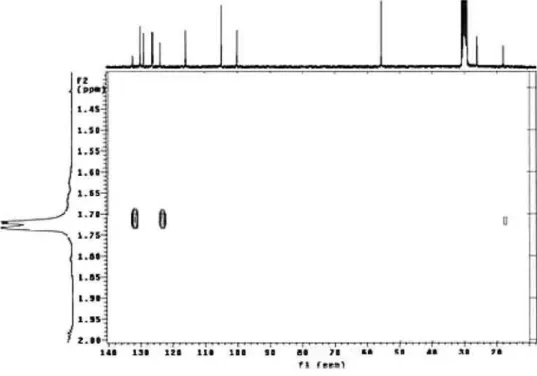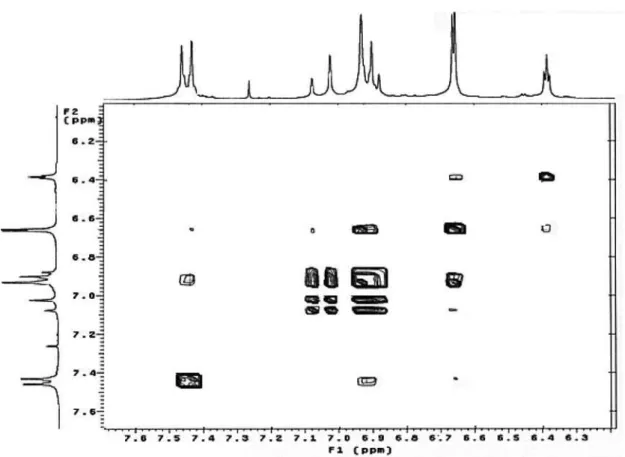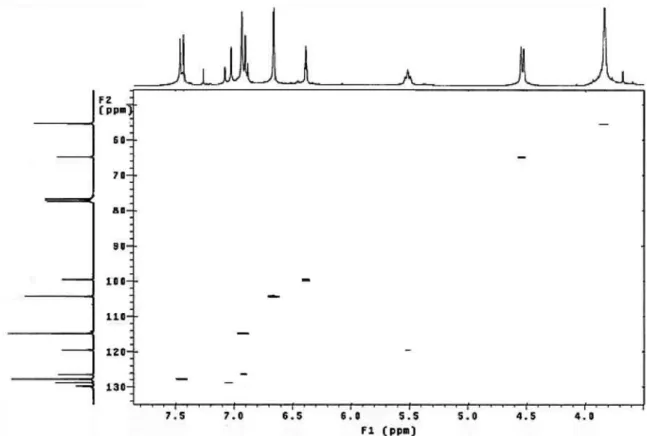Article
0103 - 5053 $6.00+0.00
*e-mail: mspa@ufpa.br
Stilbenes from
Deguelia rufescens
var.
urucu
(Ducke) A. M. G. Azevedo Leaves:
Effects on Seed Germination and Plant Growth
Lívia T. Lobo,a Geilson A. da Silva,a Manolo C. C. de Freitas,a Antonio Pedro S. Souza Filho,b Milton N. da Silva,a Alberto C. Arruda,a Giselle M. S. P. Guilhon,a Lourivaldo S. Santos,a
Alberdan S. Santosa and Mara S. P. Arruda*,a
aPrograma de Pós-Graduação em Química, Instituto de Ciências Exatas e Naturais, Universidade
Federal do Pará, Rua Augusto Corrêa 01, Guamá, 66075-970 Belém-PA, Brazil
bCentro de Pesquisa Agrolorestal da Amazônia Oriental-CPATU,
CP 48, 66095-100 Belém-PA, Brazil
A biodiversidade Amazônica pode ser uma fonte de substâncias capazes de serem utilizadas no controle de plantas daninhas. Neste estudo relatamos o isolamento e a identiicação de cinco estilbenos a partir das folhas do “timbó vermelho” (Deguelia rufescens var. urucu): 4-metoxilonchocarpeno (1); 3,5-dimetoxi-4′-hidroxi-3′-prenil-trans-estilbeno (2), lonchocarpeno (3), 3,5-dimetoxi-4′-O-prenil-trans-estilbeno (4) e pteroestilbeno (5). As substâncias 2 e 4 são novos produtos naturais, porém 2 já havia sido citada como produto de síntese. Foi avaliada a potencial atividade alelopática de 1, 2 e 4 sobre a germinação de sementes e o crescimento da planta daninha Mimosa pudica. Os efeitos observados sobre a germinação das sementes de M. pudica não variaram signiicantemente (p > 0,05) quando a análise da itotoxidade foi realizada com as substâncias isoladamente, cuja inibição máxima não ultrapassou 20%. A inibição mais intensa, quanto ao desenvolvimento da radícula e do hipocótilo, foi encontrada para o composto 4 (p < 0,05). Isoladamente, 4 causou efeito inibitório signiicativamente maior (p < 0,05) no desenvolvimento da radícula e do hipocótilo, do que 1 e 2. Quando testados aos pares, apresentaram antagonismo para a germinação de sementes e sinergismo para o desenvolvimento da radícula e hipocótilo.
The Amazon biodiversity may provide plants whose chemical substances are capable of controlling weeds. In this study we report the isolation and identiication of ive stilbenes from the leaves of “timbó vermelho” (Deguelia rufescens var. urucu): 4-methoxylonchocarpene (1); 3,5-dimethoxy-4′-hydroxy-3′-prenyl-trans-stilbene (2), lonchocarpene (3), 3,5-dimethoxy-4′ -O-prenyl-trans-stilbene (4) and pterostilbene (5). Compounds 2 and 4 are new natural products although 2 has been previously cited as synthesis product. Potential allelopathic activity for 1, 2 and 4 was evaluated over seed germination and plant growth of Mimosa pudica weed. The observed effects on seed germination did not vary signiicantly (p > 0.05) when the analysis of phytotoxicity was performed with the substances alone, the maximum inhibition did not exceed 20%. The most intense inhibitions on radicle and hypocotyl development were found for compound 4 (p < 0.05). When tested in pairs, showed antagonism for seed germination and synergism for radicle and hypocotyl development.
Keywords: Deguelia rufescens var. urucu, stilbenes, allelopathy, allelochemicals, phytotoxicity, germination and growth inhibitions
Introduction
The Amazon Forest, due its biological wealthy and diversity of species, offers an opportunity to ind
Lobo et al. 1839 Vol. 21, No. 10, 2010
those studies, emphasis should be given to the investigation with Myrcia guianensis,1 Parkia pendula,2 Tachigali myrmecophila,3Piper hispidinervium,4Virola michelli5 and Cyperus giganteus,6 which allow identiication of potent
allelochemicals.
Among the various species of native plants from the Amazon Forest, capable of providing molecules with possible use in agriculture are those from Deguelia (Derris/ Lonchocarpus) genera, known for their popular name of “timbó”. They are vines, which grow using other tree crowns, and have long been used by native Indians for ishing. Twenty-two species of timbó have been catalogued all over the world. In the Amazon the most known species are “timbó vermelho” [Deguelia rufescens var. urucu (Lonchocarpus urucu/Derrisurucu)]and “timbó branco” [Deguelia utilis (Derris nicou/Lonchocarpus utilis)],7
whose roots are a signiicant source of rotenoids.8 The fact
that these species display pesticide activities allowed their use as defensives in aquaculture.9-11
Although many Deguelia species have been the subject of phytochemical studies, little is known about the chemical constituents from the leaves of D. rufescens var. urucu. In a previous paper we reported the presence of dihydroflavonoids12 and we have further raised the
hypothesis that leaves of this species may provide substances for use in weed control handling. Thus, the aim of this research was to evaluate the allelopathic activity of leaf constituents of D. rufescens var. urucu.
Experimental
General
UV spectra were obtained from LC equipped with DAD Prominence 20A Shimadzu. NMR spectra, including 1H-1H COSY, HETCOR, HMBC experiments, were recorded on a Varian Mercury-300 spectrometer, operating at 300 MHz at
1H and 75 MHz at 13C, using d-chloroform as solvent and
internal standard. Mass spectral analyses were performed at low resolution on a Quattro-LC instrument (Micromass, Manchester, UK) provided with an ESI ion source and a triple quadrupole mass analyzer. High resolution analyses was performed on UltrOTOF-Q (Brucker, Daltonics Billerica MA, USA) at the cationiozed ion region. The heated capillary and voltage were maintained at 250 °C and 3 kV, respectively. A 20 V cone energy for ion extraction and mass spectrometry data were acquired at positive mode for all compounds. HPLC was carried out in a preparative LC-8A Shimadzu system with SPD-10AV Shimadzu UV detector (Tokyo, Japan); using a Phenomenex Gemini C18 column (250 × 10 mm, 5μ), an isocratic system of
water:acetonitrile (30:70) and a low rate of 4.7 mL min−1.
Detection was performed at 270 and 320 nm. All solvents were iltered through a 0.45 µm membrane ilter prior to analysis. Absorbance measurements were recorded on a Spectrum UV SP-220® spectrophotometer.
Plant material
Approximately 2.0 kg of green leaves from Deguelia rufescens var. urucu (Ducke) A. M. G. Azevedo - as synonymous Lonchocarpus urucu Killip & A. C. Smith and Derrisurucu (Killip & A. C. Smith) J. F. Macbr. - were collected at Campo Experimental da Embrapa Amazônia Oriental, located in Belém, state of Pará, Brazil, when the plants were lowering. A fertile sample was obtained and stored at the Botanical Laboratory and a voucher was registered (IAN-179599).
Extraction and isolation
700 g of dried and powdered leaves of D. rufescens var. urucu were extracted with ethanol at room temperature. The solvent was removed under vacuum furnishing a residue (50 g). The crude ethanol residue (30 g) was iltered on silica gel column chromatography with gradient elution of hexane:ethyl acetate (9:1, 7:3, 5:5 and 0:10) and ethyl acetate:methanol (5:5 and 0:10), yielding six fractions named DU-1 (1.28 g), DU-2 (2.37 g), DU-3 (5.17 g), DU-4 (5.36 g), DU-5 (3.53 g) and DU-6 (3.75 g), respectively. Fraction DU-2 (0.5 g) was puriied by semi-preparative HPLC yielding compounds 1 (43 mg), 2 (7 mg), 3 (90 mg), 4 (21 mg) and 5 (3 mg) which showed chromatographic peaks with retention times 10.13, 11.80, 14.91, 21.08 and 23.96 min, respectively.
Bioassays analysis of allelopathic activity
The germination bioassay was developed in a controlled temperature chamber 25 °C for 12 h of photoperiod. Germination was monitored for ten days, with daily counting and elimination of germinated seeds. Germinated seeds were considered those with 2.0 cm or more in length of radicle. Each Petri dish (9.0 cm diameter) was covered with qualitative ilter paper received 25 seeds.
The substances were tested separately and in pairs, in a single 150 mg L−1 concentration. Each Petri dish received
3.0 mL of solution test. Specifically for bioassays of substances tested in pairs, it was used 50% of the volume for each substance. After the eluent evaporation, an equivalent volume of distilled water was added, to maintain the original concentration. The solutions were added just once, at the beginning of the tests, after that only distilled water was added whenever necessary.
The plant used as an indicator of allelopathic effects was the specie malícia (Mimosa pudica) weed. The seeds of the specie were collected in pasture ields in the municipality of Terra Alta, Pará State; they went through the cleaning process and were treated to break the dormancy by immersion in sulphuric acid for 20 min, as speciied by Souza Filho et al.13
Experimental design and statistical data analysis
A completely randomized design was used for all bioassays, with four replications, using distilled water as control treatment. The data were transformed to arc sine
√x, to follow normal distribution. The values obtained were submitted to variance analysis, using F-test, and when the treatment effects presented signiicant differences (p < 0.05) and the means were compared using the Tukey test. Computer program statistical analysis system (SAS) was used in analysis.14
3,5-Dimethoxy-4′-hidroxy-3′-prenyl-trans-stilbene (4) Yellow crystals; IR νmax cm−1 2916, 1584, 1556,
1509, 1454, 1146, 1063, 957, 824 (thin solid film); UV λmax/nm(water/acetonitrile) 215, 235, 305, 317; HRESIMS (positive mode) [M+Na]+ Found: 347.1657.
Calc. for C21H24O3Na: 347.1623; ESIMS: 347, 325 [M+H]+,
284 [M+H−41(C3H5)]+; 1H and 13C NMR spectral data: see
Tables 1 and 2.
Results and Discussion
Phytochemical investigation
Chromatography column followed by semi-preparative HPLC of the ethanolic extract of D. rufescens leaves, led to the isolation of compounds 1-5 (Figure 1). Compounds 1, 2, 3, and 5 were identiied as 4-methoxylonchocarpene,15
3,5-dimethoxy-4′-hydroxy-3′-prenyl-trans-stilbene, lonchocarpene16 and pterostilbene,17 respectively, by
comparison of their spectral data with those reported in literature.
Compound 4 was obtained as a pale yellow amorphous solid. The HRESIMS displayed a pseudomolecular ion [M+Na]+ at m/z 347.1657, consistent with the molecular
formula C21H24O3Na (calc. for C21H24O3Na, 347.1623), which was further corroborated by the NMR data. The d
6.0-7.5 ppm region of the 1H NMR spectrum of 4 (Table 1)
showed resonances for two pairs of equivalent ortho -aromatic protons from one 1,4-disubstituted phenyl ring, at
d 6.91 and 7.44 (d, J 8.7 Hz, 2H each), three meta-coupled aromatic protons at d 6.38 (d, J 2.1 Hz, 1H) and 6.65 (d, J 2.1 Hz, 2H) from one 1,3,5-trisubstituted phenyl ring, as well as a pair of trans-oleinic protons, at d6.91 and 7.15 (d, J 16.0 Hz, 1H each), typical of a trans-stilbene.16 In
addition, was observed a six-proton singlet at d 3.83 ppm due to two magnetically equivalent OMe groups, and signals due to a O-prenyl group [d 4.53 (d, J 6.9 Hz, 2H), 5.51 (t, J 6.9 Hz, 1H), 1.76 and 1.81 (s, 3H each)]. The 13C NMR, HSQC and DEPT spectra of 4 (Table 1)
displayed 16 signals assignable to 21 carbons of a stilbene containing a prenyloxy group and two methoxy groups, thus revealing the presence of ive pairs of equivalent carbons. The chemicals shifts for H-7 and H-8 at d6.91 and7.05 ppm, respectively, were conirmed on the basis of the HMBCcorrelations of H-7 with C-2/6 (d 104.3 ppm) and H-8 with C-2′/6′ (Figure 2). Moreover, the long-range correlation between H-3′/5′ (d6.90 ppm) and the signal at
1 MeO OMe R1 O 3 5 7 8 1' 3' 4' 6' 2'' 4''
1 R1 = OMe
3 R1 = H
1 MeO OMe R2 OR1 3 5 7 8 1' 3' 4' 6'
2 R1 = H; R2 = CH2CH=C(CH3)2 4 R1 = CH
2CH=C(CH3)2; R2 = H
5 R1 = R2 = H
Lobo et al. 1841 Vol. 21, No. 10, 2010
d 129.8 ppm conirmed the C-1′ attribution. Correlations were also observed between H-8 and carbons signals at
d129.8 (C-1′) and 139.7 ppm, than the signal at d 139.7 ppm that was attributed to C-1. Compound 4 was then elucidated
as (E)-3,5-dimethoxy-4′-O-prenylstilbene.
The occurrence of the 3´-O-prenylstilbene analogue
2 as a natural product and its 13C NMR data (Table1) are
here reported for the irst time. Compound 2 was previously
characterized as a synthesis product.18
Phytotoxicity of ethanolic extract and puriied compounds
The effects of ethanolic extract over germination and the development of the weed malícia are showed in Figure 3. Inhibiting effects above 50% were observed with maximum veriied on the hypocotyl development (58%). The effects promoted by 1, 2 and 4, over seed germination (Figure 4),
did not vary signiicantly (p < 0.05) when the substances were considered separately. For 1, 2 and 4 the intensity
of inhibitions on seed germination did not exceed 20% however; it was slightly higher for 2. Lower inhibiting
effects were observed when pairs 1+2 and 2+4 were tested,
indicating antagonistic effects. Comparisons between 1, 4
and 1+4 did not show signiicant differences (p > 0.05),
although slight superiority in the intensity of effects is observed in the mixture test.
Effects over radicle development of 1, 2 and 4 separated
and combined in pairs are showed in Figure 5. Separately
1 and 2 presentedinhibitory activity below 10%, without
any signiicant difference (p > 0.05) between them. From the three stilbenes tested, 4 presented the highest inhibitory
1 MeO OMe O 3 5 7 8 1' 3' 4' 6' 4 1'' 2'' 4'' 5'' 6 4 2' 5' 2 3''
Figure 2. Key HMBC (H → C) correlations of compound 4.
Table 1. 1H and 13C NMR chemical shift (d in ppm) assignments for compounds 2 e 4 in CDCl3a
Position 2 4
dΗ dC dΗ dC
1 140.9 139.7
2/6 6.72 (d, 2.4)b 104.8 6.65 (d, 2.1) 104.3
3/5 162.0 160,9
4 6.36 (t, 2.4) 100.0 6.38 (t, 2.1) 99.5
7 6.95 (d, 16.3) 126.2 6.91 (d, 16.0) 126.4
8 7.15 (d, 16.3) 130.0 7.15 (d, 16.0) 128.8
1′ 129.8 129.8
2′ 7.32 (d, 1.8) 128.9 7.44 (d, 8.7) 127.7
3′ 129.0 6.90 (d, 8.7) 114.8
4′ 155.9 158.6
5′ 6.84 (d, 8.1) 115.9 6.90 (d, 8.7) 114.8
6′ 7.26
(dd, 8.1, 1.8)
126.1 7.44 (d, 8.7) 127.7
1′′ 3.33 (d, 7.5) 29.0 4.53 (d, 6.9) 64.7
2′′ 5.34 (t, 7.5) 123.7 5.51 (t, 6.9) 119.5
3′′ 132.4 138.3
Me-4′′ 1.72 (s) 25.8 1.81 (s) 25.8
Me-5′′ 1.73 (s) 17.8 1.76 (s) 18.2
2×OMe 3.80 (s) 55.5 3.83 (s) 55.3
a Spectra were recorded at 300 MHz for 1H NMR and 75 MHz for 13C NMR. b Multiplicity and coupling constant (J, Hz) are in parenthesis.
Figure 4. Allelopathic effect of stilbenes 1, 2 and 4, separately, and in pairs, over seed germination of malícia weed seedling. Data is shown in percentages of inhibition in relation to control treatment; distilled water. Letters show signiicant differences by the Tukey test (5%).
Figure 5. Allelopathic effect of stilbenes 1, 2 e 4, separately, and in pairs, over root development of malícia weed seedling. Data is shown in percentages of inhibition in relation to control treatment; distilled water. Letters show signiicant differences by the Tukey test (5%).
activity, around 30%, signiicantly higher (p < 0.05) than 1 and 2. The standard response to the different combinations, two by two, between the three compounds, was completely different from that observed on seeds germination. The inhibitory effects promoted by 1+2 and 2+4 were signiicantly higher (p < 0.05) than those of the separate substances. For 1+2 the effect was four times larger than for the compounds separately, while for 2+4 was 2.5 times higher. On both cases synergism was observed, contrasting with the results for seed germination.
Unlike other results on the effects promoted on the radicle development, 1+4 was signiicantly equal (p > 0.05) to 4, although, quantitatively, 4 presented a higher inhibiting
power. Both 4 and 1+4 showed inhibitory effects (p < 0.05) larger than 1.
Compounds 1 and 2 separately, presented the lowest potential for inhibitory of hypocotyl development (Figure 6), below 10%. Compound 4 showed strongest activity, being signiicantly higher (p < 0.05) than 1 and 2. For pairs of the three compounds, the inhibitory effects were more intense (p < 0.05) than those caused by the single substances, indicating synergic effect.
Lobo et al. 1843 Vol. 21, No. 10, 2010
Figure 6. Allelopathic effect of stilbenes 1, 2 e 4, separately, and in pairs, over the hypocotyl development of malícia weed seedling. Data is shown in percentages of inhibition in relation to control treatment; distilled water. Letters show signiicant differences by the Tukey test (5%).
inhibiting potential for roots and hypocotyl development of malícia weeds. The activity of the substances, when tested in pairs, tended to present antagonism for seed germination and synergism for seedling development.
Different biological activities were determined for stilbenes, among others antibiotics, antioxidant, bactericide, algicide, insect and growth regulatory activity.19-24 Small
differences in the chemical structure of certain substances may be favorable for an increase in allelopathic activity.25
Compounds 1 and 2 showed more structural similarities to each other when compared to 4. Those variations were not suficient to promote differences in the inhibiting activity of seed germination. When the effects on root and hypocotyl development were analyzed, 1 and 2 did not differ much for
inhibiting capacity, however 4 displayed more magnitude of inhibition.
Phenolic compounds represents the majority of the allelopathic agents identified.26,27 In plant, the
effects attributed to allelopathy phenomenon resulting of compounds that are produced and released into the environment. Thus, the activity of a mixture of allelochemicals is determined by its concentration and by positive or negative interaction between these chemical constituents. The combination of allelochemicals involves ixed concentrations and inferences are based on increased activity in relation to the effects promoted by substance alone, which concludes that there is synergy, and the reduction of activity (antagonism). In our study, we observed both effects among the three substances tested. The bioassay of germination, the trend was the occurrence of antagonism, while in the radicle and hypocotyl developments, synergisms. The manifestation of synergism or antagonism apparently is not only dependent on the ability of the substances tested have to enhance the activity of another, but also of the target to be analyzed.
All the results allow us to conirm plant species from Amazon rainforest as alternative sources of molecules with properties for use in weed management, adding value to these species and contributing to Amazon rainforest preservation.
Supplementary Information
Supplementary data are available free of charge at http://jbcs.sbq.org.br, as PDF ile.
Acknowledgment
We are grateful to FAPESPA (Fundação de Amparo à Pesquisa do Estado do Pará, Brazil) for inancial support and we thanks to CNPq for a grant. We acknowledge Prof. Norberto Peporine Lopes for HRMS measurements.
References
1. Souza Filho, A. P. S.; Santos, R. A.; Santos, L. S.; Guilhon, G. M. P.; Santos, A. S.; Arruda, M. S. P.; Müller, A. H.; Arruda, A. C.; Planta Daninha2006, 24, 649.
2. Souza Filho, A. P. S.; Fonseca, M. L.; Arruda, M. S. P.; Planta Daninha2005, 23, 565.
3. Lôbo, L. T.; Castro, K. C. F.; Arruda, M. S. P.; Silva, M. N.; Arruda, A. C.; Müller, A. H.; Guilhon, G. M. P.; Santos, A. S.; Souza Filho, A. P. S.; Quim. Nova2008, 31, 493.
5. Santos, L. S.; Borges, F. C.; Oliveira, M. N.; Ferreira, I. C. S.; Guilhon, G. M. P.; Souza Filho, A. P. S.; Santos, A. S.; Arruda, M. S. P.; Müller, A. H; Arruda, A. C.; Allelopathy J.2007, 20, 235.
6. Vilhena, K. S. S.; Guilhon, G. M. P.; Souza Filho, A. P. S.; Zoghbi, M. G. B.; Santos, L. S.; Arruda, M. S. P.; Arruda, A. C.; Allelopathy J.2009, 23, 221.
7. Da Conceição, H. E. O.; Pinto, J. E. B. P.; De Santiago, E. J. A.; Gonçalves, A. A. S.; Ciênc. Agrotec.2002, 26, 472. 8. Mascaro, U. C. P.; Rodrigues, L. A.; Bastos, J. K.; Santos, E.;
da Costa, J. P. C.; Pesq. Vet. Bras. 1998, 18,53.
9. Hien, P .P.; Gortnizka, H.; Kraemer, R.; Omonrice2003, 11, 83.
10. Howard, R. K.; Environ. Biol. Fishes1988, 24, 93. 11. Scarnecchia, D. L.; J. Iowa Acad. Sci. 1988, 95, 55.
12. Lôbo, L. T.; da Silva, G. A.; Ferreira, M.; da Silva, M. N.; Santos, A. S.; Arruda, A. C.; Guilhon, G. M. P.; Santos, L. S.; Borges, R. S.; Arruda, M. S. P.; J. Braz. Chem. Soc.2009, 20, 1082. 13. Souza Filho, A. P. S.; Dutra, S.; Silva, M. A. M. M.; Planta
Daninha1998, 25, 3.
14. Statistical Analysis System.SAS Procedures Guide. Version 6, 3rd ed., Statistical Analysis System Institute: Cary, NC, 1990. 15. Fang, N.; Casida, J. E.; J. Nat. Prod.1999, 62, 205.
16. Kaouadji, M.; Agban, A.; Mariotte, A. M.; Tissut, M.; J. Nat. Prod.1986, 49, 281.
17. Fuendjiepa, V.; Wandji, J.; Tillequinc, F.; Mulhollandd, D. A.; Budzikiewicze, H.; Fomumb, Z. T.; Nyembab, A. M.; Koch, M.; Phytochemistry2002, 60, 803.
18. Li, Y. Q.; Song, Q. L.; Chen, P.; Zhao, W.; Wang, S.; Chem. Res. Chin. Univ.2006, 22, 742.
19. Kato, E.; Tokunaga, Y.; Sakan, F.; J. Agric. Food Chem.2009, 57, 2544.
20. Mizuno, C. S.; Schrader, K. K.; Rimando, A. M.; J. Agric. Food Chem. 2008, 56, 9140.
21. Lin, L. G.; Yang, X. Z.; Tang, C. P.; Phytochemistry2008, 69, 457.
22. Lee, J. P.; Min, B. S.; Na, R. B.; Phytochemistry2003, 64, 759. 23. Torres, P.; Avila, J. G.; Rorno, V. A.; Phytochemistry2003, 64,
463.
24. Taylor, R. J.; Shaw, D. C.; Can. J. Bot.1983, 61, 279. 25. Souza Filho, A. P. S.; Borges, F. C.; Santos, L. S.; Planta
Daninha2006, 24, 205.
26. Rice, E. L.; Allelopathy, Academic Press: New York, 1984. 27. Xuan, T. D.; Tsuzuki, E.; Terao, H.; Matsui, M.; Khanh, T. D.;
Plant Prod. Sci.2003, 6, 165.
Supplementary Information
J. Braz. Chem. Soc., Vol. 21, No. 10, S1-S7, 2010. Printed in Brazil - ©2010 Sociedade Brasileira de Química 0103 - 5053 $6.00+0.00
*e-mail: mspa@ufpa.br
Stilbenes from
Deguelia rufescens
var.
urucu
(Ducke) A. M. G. Azevedo Leaves:
Effects on Seed Germination and Plant Growth
Lívia T. Lobo,a Geilson A. da Silva,a Manolo C. C. de Freitas,a Antonio Pedro S. Souza Filho,b Milton N. da Silva,a Alberto C. Arruda,a Giselle M. S. P. Guilhon,a Lourivaldo S. Santos,a
Alberdan S. Santosa and Mara S. P. Arrudaa*
aPrograma de Pós-Graduação em Química, Instituto de Ciências Exatas e Naturais, Universidade
Federal do Pará, Rua Augusto Corrêa 01, Guamá, 66075-970 Belém-PA, Brazil
bCentro de Pesquisa Agrolorestal da Amazônia Oriental-CPATU,
CP 48, 66095-100 Belém-PA, Brazil
Figure S1. 1H NMR spectrum [in (CD
Figure S2. 13C NMR spectrum [in (CD
3)2CO, 75 MHz] of the compound 2 isolated from leaves of Deguelia rufescens var. urucu.
Lobo et al. S3
Vol. 21, No. 10, 2010
Figure S4. HMBC NMR experiment [in (CD3)2CO, 300 × 75 MHz] of the compound 2 isolated from leaves of Deguelia rufescens var. urucu.
Figure S6. HMBC NMR experiment of the compound 2 (expansion 2).
Figure S7. 1H NMR spectrum (in CDCl
Lobo et al. S5
Vol. 21, No. 10, 2010
Figure S8. COSY 1Hx1HNMR experiment (in CDCl
3, 300 MHz) of the compound 4 isolated from leaves of Deguelia rufescens var. urucu.
Figure S9. 13C NMR spectrum (in CDCl
Figure S10. HETCOR NMR experiment (in CDCl3, 300 × 75 MHz) of the compound 4 isolated from leaves of Deguelia rufescens var. urucu.
Lobo et al. S7
Vol. 21, No. 10, 2010
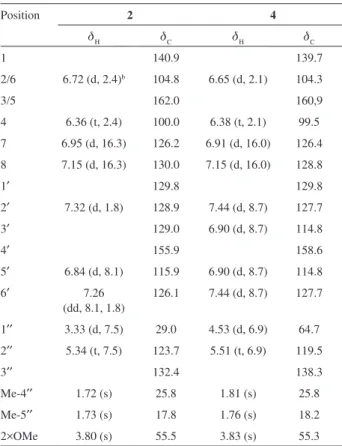

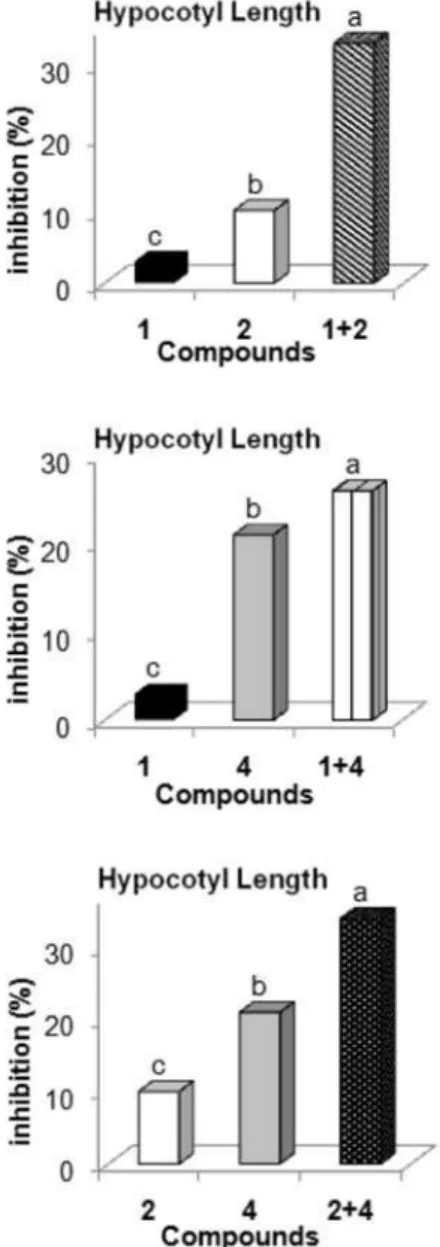
![Figure S1. 1 H NMR spectrum [in (CD 3 ) 2 CO, 300 MHz] of the compound 2 isolated from leaves of Deguelia rufescens var](https://thumb-eu.123doks.com/thumbv2/123dok_br/18993945.461593/8.892.156.746.492.936/figure-nmr-spectrum-compound-isolated-leaves-deguelia-rufescens.webp)
![Figure S2. 13 C NMR spectrum [in (CD 3 ) 2 CO, 75 MHz] of the compound 2 isolated from leaves of Deguelia rufescens var](https://thumb-eu.123doks.com/thumbv2/123dok_br/18993945.461593/9.892.99.763.124.558/figure-nmr-spectrum-compound-isolated-leaves-deguelia-rufescens.webp)
![Figure S4. HMBC NMR experiment [in (CD 3 ) 2 CO, 300 × 75 MHz] of the compound 2 isolated from leaves of Deguelia rufescens var](https://thumb-eu.123doks.com/thumbv2/123dok_br/18993945.461593/10.892.172.749.120.510/figure-hmbc-experiment-compound-isolated-leaves-deguelia-rufescens.webp)
